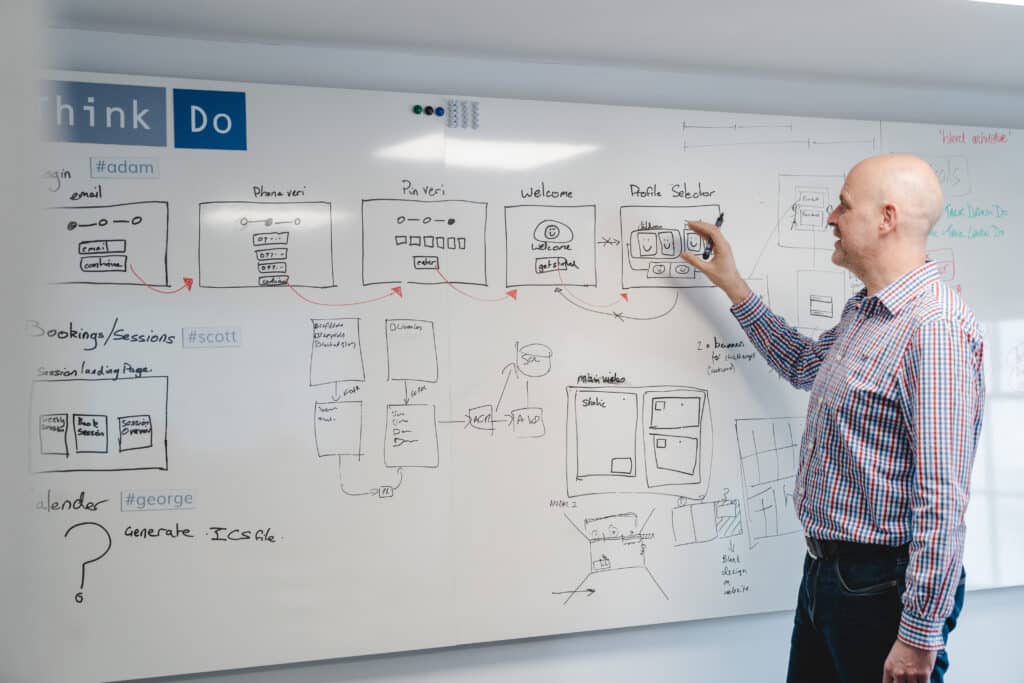5 Signs Legacy Technology is Holding Back Your Growth

The past two years have changed the digital landscape forever. While people had spent years considering the importance of digital transformation, no one could have predicted the speed at which industries would have to modernise in order to adapt to a remote workplace. More businesses than ever, even those in sectors that relied heavily on older technology, are joining the digital revolution that’s currently taking place.
Your current business processes might work enough to get you by but not enough for you to grow. To take full advantage of a cloud-based, scalable service, business leaders must first understand how legacy systems are holding back their organisations. That’s easier said than done and often comes too late when the damage is already felt.
In this article, we explore five ways legacy technology is holding back your growth by looking at how:
- they aren’t optimised for hybrid work.
- why they struggle to support customer journeys in digital landscapes.
- legacy systems guarantee you’ll fall behind the competition.
- their inefficient processes hurt your bottom line.
- why they put your data security at risk.
Suggested Reading: Learn how legacy systems are barriers to your growth, and how to innovate mission-critical cloud applications, in our free eBook.
It isn’t optimised for hybrid work
Covid-19 has quickly become a tired topic. Yet, it pops up time and time again, especially when it comes to the world of business. Why? Because it changed the way we work forever. Hybrid and remote work before the pandemic stood at around 12% in the UK. Even with the end of social distancing and lockdown, nearly a quarter of all UK workers are still engaged in hybrid working.1 The hybrid work model isn’t just popular with employees. Executives, directors and business leaders also recognise the value of hybrid work.
- Employees excel in a healthy work-life balance and this increases their productivity.
- Money is saved on the commute and organisations reduce office overheads.
- Hybrid work also encourages innovation and promotes IT upskilling in the workforce.
Setting up systems that support a hybrid workplace prevents bottlenecks associated with strictly in-person teams. The process at work should be seamless and encourage collaboration, regardless of where employees are located.
Cloud-based systems, unlike outdated technology, give access to data from a range of devices for every team member. They also don’t rely on the middleware that so often adds complexity and supports overheads, bridging applications and operating systems.
Your legacy software may need replacing if:
1) your team is struggling to collaborate in a hybrid model
2) your processes are bogged down by manual tasks

It cannot support consumerism in a digital landscape
Another sign that your technology software is holding you back is the way your customers interact with your product. Consumers expect freedom in how they engage with services. Digital consumerism almost single-handedly propped up the world economy during the pandemic. The UK’s digital revenue growth exploded during the pandemic and continues to do so. Last year, it boasted the third biggest year-on-year growth in the world.2
More consumers than ever want digital options. If that means accessing your services remotely, you need a way to facilitate that demand. Of course, this can be a daunting task for even the most established businesses. Which is why working with the right tech partner is important for overcoming challenges in your industry.
Case in point: Explore Learning is a leading private tutor provider with 100 centres across the UK. Their key business systems were dependent on a SaaS provider. Talk Think Do built an alternative, fully remote, online tutoring system in weeks on Azure. This gave them:
- full autonomy over their data.
- the option to own a perpetual, irrevocable, royalty-free licence.
Perhaps most importantly, it’s a system that accommodated busy after-school periods, a decision that proved pivotal in helping Explore Learning get through the pandemic. They were able to support families throughout the lockdown because they replaced their original legacy application with our cloud-based solution. Post-pandemic, one-third of Explore Learning’s students still choose the online offering exclusively, a marker of its success in helping children learn. Check out the full story: Explore Learning: Enabling innovation with an inside out digital transformation.
You’re falling behind the competition
In the current economic climate, competition is fierce whichever industry you’re in. To complicate matters even more, the cost-of-living crisis is having an adverse effect on your business. On the one hand, your cloud-based investments must display returns, during a time when expenditure is low. Yet, to set your services apart from the crowd, you must unleash the full potential of your offer through flexible and scalable tech.
Does any of this sound familiar? If so, it could be a sign that you need to modernise to newer technologies. And if there’s any doubt as to whether improving business operations through cloud-based technology is worth it, you need only to refer back to our previous case study. Trying to work efficiently, scalably and with minimal risks is difficult without modern, cloud-native technologies. Modernising legacy technology with bespoke services, ensures:
- You have the opportunity to tactically innovate.
- You can maintain a strategic, competitive advantage.
It isn’t cost-effective
Your outdated software most likely relies on an existing data centre. Even if your data is already stored in the cloud, without proper architecting, storage is expensive and hard to report against. When it’s managed into a data lake, cloud storage is more affordable and actually designed for business reporting.
Instead of simply lifting and shifting into the cloud, comprehensive architecting by a team of experts will allow for a microservices design, reducing costs and enabling scale. We’ve already explored the growth-enabling benefits of cloud databases in this article.
Cloud databases reduce costs to best-in-class capabilities too. It’s easier to run complex, mission-critical applications on software that accommodates a full suite of technical requirements. This includes:
- advanced analytics.
- machine learning tools.
These mitigate human errors and promote workflow automation. Not to mention, they also enhance employees’ experiences by streamlining otherwise tedious manual tasks.
If you find that:
- Scaling your legacy technologies is too expensive.
- Data and maintenance costs run off with themselves.
It may be time to refactor your legacy applications to the cloud.

Your data isn’t securely stored
The UK government reported a decrease in security monitoring (40% down to 35%) in 2020.3 The main reason behind this was that businesses often struggle to monitor multiple endpoints. The same report shows that in the last 12 months:
- 19% of businesses tested staff with mock phishing exercises.
- 17% carried out a security audit.
- 14% invested in threat intelligence.
These low numbers and a decrease in overall security monitoring can be attributed to the disruption it causes to business workflow. Which is why the cloud is becoming one of the most secure places to store sensitive data. According to Oracle 66% of organisations claim the biggest benefit of cloud is security.4 Cloud platforms such as Microsoft Azure allow for multi-layered defences that mainly comprise four elements.
Data entry should be secure in your organisation. If your hardware is legacy (meaning no longer supported by the manufacturer via patched or updated software) or your databases are easily accessible by non-compliant individuals – these are signs that you must modernise your network security.
Pro tip: Want to assess your current security status? Check out the Cyber Essentials Certification Programme to find out if you need to switch up your data security protocols.5
Leave your legacy technology behind with Talk Think Do
Now you know five ways legacy technology impedes growth. The next question to consider is whether any of them ring true for your business.
We understand that changing over to cloud-based solutions is a big step. That’s why at Talk Think Do, we offer a full migration service, tailored specifically to evolve and support your business critical applications. Want to improve operational efficiency and enable growth? Contact us today to explore the right steps for you.

1 Is hybrid working here to stay? | Office for National Statistics
2 Digital-First Consumerism Is Driving An Online Spending Boom | Forbes
3 Cyber Security Breaches Survey 2022 | UK Government
4 7 Reasons Why The Cloud Is More Secure | Oracle Cloud Security
5 Cyber Essentials Scheme: overview | GOV.UK
Get access to our monthly
roundup of news and insights
You can unsubscribe from these communications at any time. For more information on how to unsubscribe, our privacy practices, and how we are committed to protecting and respecting your privacy, please review our Privacy Policy.
See our Latest Insights
Working as One Team: How Our Business Analysts Bridge Vision and Delivery
When clients partner with us, they often expect engineers and designers. But one of the most powerful roles behind a successful digital product is often less visible: the Business Analyst (BA). At Talk Think Do, BAs aren’t just requirement-gatherers. We’re connectors, between vision and execution, users and features, partners and platforms. In the recent delivery…
Implementing RAG AI Search on On-Premise Files with our AI Search Accelerator
As demand for AI‑powered tools like Microsoft Copilot grows, many organisations are asking the same question: “How can we harness the power of generative AI without moving our sensitive data to the cloud?” In this guide, we’ll explain why Retrieval‑Augmented Generation (RAG) is so effective for on‑premise data and walk through a practical approach using…
Using AI to Strengthen ISO 27001 Compliance
Preparing for our ISO 27001:2022 recertification, and a transition from the 2013 standard, was no small task. As a custom software company handling sensitive client data, we hold ourselves to high standards around security and compliance. But this year, we approached the challenge differently. We built and deployed a custom AI Copilot agent to help…
Legacy systems are costing your business growth.
Get your free guide to adopting cloud software to drive business growth.




